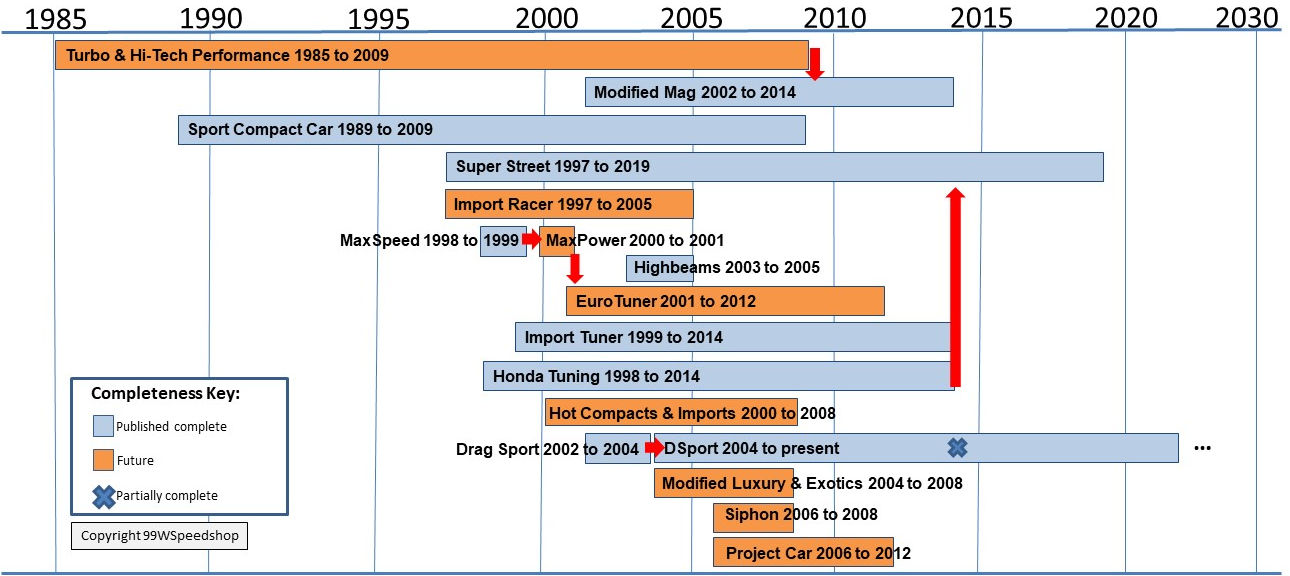
OVERVIEW:
This content section focuses on magazines covering tuner vehicles. These typically feature modified foreign production
vehicles that might be called JDM, hot hatches or sports compact cars. The image below shows the lineage and life span of planned titles.
We are excited to add this new section. Unlike other older magazines in our library, tuner magazines are relatively new (recent history) and therefore still held by enthusiasts. If you have images to send us, or if you know of other tuner titles, please contact us using this email address: info_99wspeedshop@yahoo.com.

THE TIMELINE OF TUNERS, STREET RACING, DRAG RACING AND DRIFTING
As noted in other sections of this website, the emergence of magazines focused on specific vehicles or genres, e.g., hot rods, vans, VWs, tuners, etc., tends
to lag what people are actually doing with cars. In the case of tuners, young Gen-X and Gen-Y men and women were doing performance and styling upgrades to
imported cars as much as two decades before a significant number of tuner magazines emerged. Here are the timeline highlights:
- In 1973, first generation Japanese emigrants to the U.S. or issei began to import Japanese-styled cars over to the U.S. These were typically Datsun 510s, Toyota Corollas, and Honda Civics.
- In the late 1970s and early 1980s, Japanese vehicles, mostly smaller Hondas (Civic, Prelude), Toyotas (Celica, Corolla, Supra), Nissans (Datsun 510) and Mazdas (RX-2, RX-3) gained popularity in Southern California. Meiji Market Plaza in Gardena, California, become an established weekend late-night meet-up location for street racing. Young Asian-Americans and first generation street racers from Japan and Okinawa played a particularly important role in the development of the early street racing scene.
- Many enthusiasts in Southern California, especially Gardena, Torrance and Palo Verdes, began to modify their compact Japanese cars, following similar trends that originated in Japan such as the enhanced paint schemes, modified exhausts, and engine carburetion. As the import racers and car aesthetics grew in popularity and numbers, so did the competition. But more racers from around these three cities began to show up too.
- From 1983 to 1986, import and midnight racers started to meet at another local restaurant called Naugles which was located on Western Avenue and 186th Street in Torrance. Naugles is noteworthy in that the import racing scene was now expanding and gaining popularity in other Southern California communities. This continued to expand to Carson and Long Beach, California.
- Kipp Kington started Turbo and Hi-Tech Performance magazine in July 1985. This was based on the premise that there would be strong interest in performance upgrades using turbos and electronic fuel injection (EFI). By September, 1986, the magazine featured the first hopped-up Honda CRX with nitrous-enhanced fuel injection.
- In 1987, Turbo featured a Cartech-modified CRX Si that sported a Rotomaster RM90 turbo and an intercooler. The car accelerated from zero to 60 miles per hour in 5.4 seconds. By the next year, tuners were not just tinkering with turbos but were also adding wheel and tire upgrades.
- McMullen-Yee Publishing, always great at spotting new trends and getting a step ahead of other publishers, started Sport Compact Car magazine in 1989. Their content generally followed the rapid evolution of styling and performance upgrades by tuners.
- Frank Choi put together the first Battle of the Imports race in July, 1990 at Palmdale, California. This signaled the real start of sanctioned import drag racing. This event was more regional and the only game in town until the IDRC was formed in 1998. Import drag racing was clearly becoming a national sport. The NHRA and SCCA also tried to get into the game.
- Also in 1990, import manufacturers were now offering turbocharged cars. A real stand-out was the Nissan 300ZX Twin Turbo sporting 300 hp.
- Drifting had been popular in Japan, but the first recorded drifting event in the U.S. occurred in 1996 at Willow Springs Raceway. It was hosted by the Japanese magazine Option. Drifting has since exploded across the world.
- By the mid to late 1990s, the tuner "craze" had radiated outward across the U.S. like rap and fashion trends. A huge number of magazine titles emerged between 1997 to 2004. But by 2014, most tuner magazines ended print production. This left Super Street and DSport as the last few titles still in print.
CONTACT US:
Email: info_99wspeedshop@yahoo.com